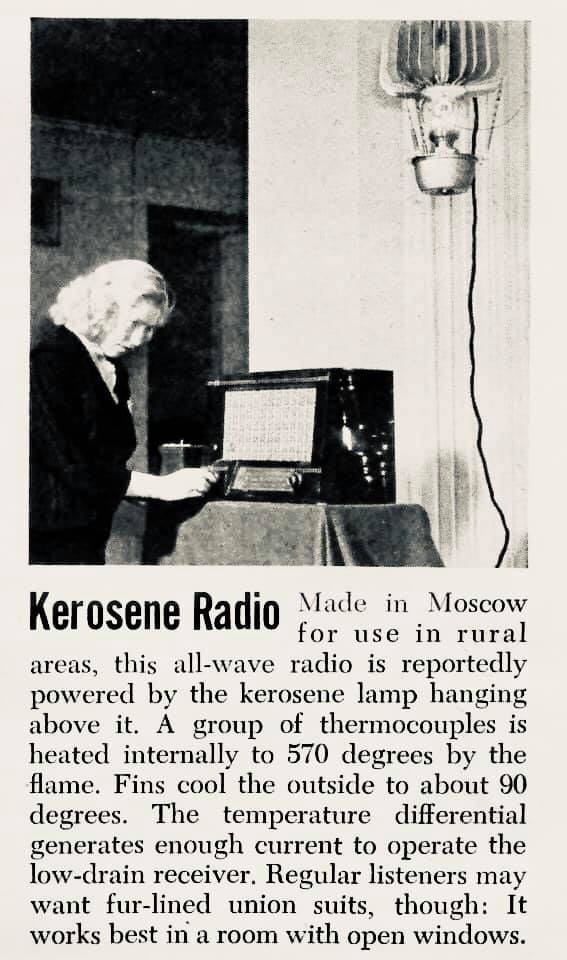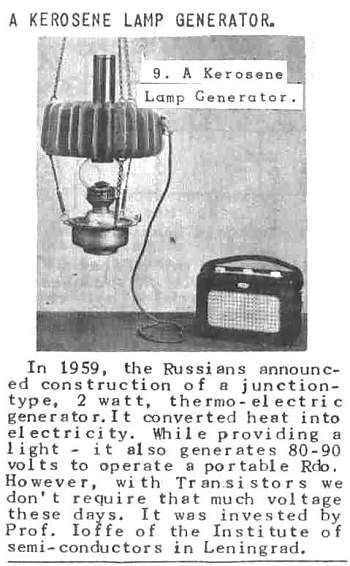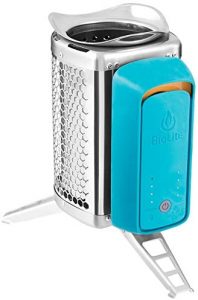 Many thanks to SWLing Post contributor, David Day, who recently shares the newspaper clipping above.
Many thanks to SWLing Post contributor, David Day, who recently shares the newspaper clipping above.
I was not aware of this Cold War era kerosene lamp generator, but it’s an ingenious use of the thermoelectric effect for power generation. I found yet another another clipping online:
Devices that work off of thermoelectric effect have been around many decades.
I’ve often thought about purchasing a BioLite camp stove–the same one Anil Raj mentioned in our Radio Challenge II–as a companion to charge devices while camping off-grid.
BioLite now makes a more efficient (albeit pricier) stove that produces more power with less fuel.
At the end of the day, I find it so easy to use solar power to recharge larger LiFePo batteries, I’ve never invested in the BioLite.
With one large LiFePo battery, I’m able to power multiple devices including an inverter if necessary.
I’m very curious how many models of kerosene lamp generators were made back in the day and how useful they were for powering other low-drain devices.
Please comment if you’ve ever used a kerosene generator. We have readers from across the globe, so I imagine someone may have at least seen one of these in person and potentially used it to power a radio!
Oh, and obviously I need to think up another SWLing Post Radio Challenge–it’s been ages since our last!



I have owned a LUFO kerosene lantern/fadio for about 10 years
My grandkids think it is amazing to sit and lister to the radio!
I have one of those generators. If someone is interested in buying it email me at razvan.379 at gmail
Hi Rezvan.
How much is the price? I am interested to buy it. Please let me know. Thank you!
I have 2.2Kw Diesel generator that powers the whole house during outages and use kerosene in it.
More efficient.
You say you’re using kerosene in your diesel generator. Are you able to use straight kerosene in your diesel generator??
I believe that kerosene is the same thing as #1 diesel. This is the reason that in the USA kerosene sold in bulk or containers holding over 5 gallons must be dyed red.
A much higher power application of a kerosene flame is the Absorption fridge https://youtu.be/KDPgGDCdAo4
Douglas Self has a page on his site that covers thermopile / thermoelectric electrical generators – from Seebeck’s discovery of the effect named after him, through many kerosine & other heat source powered generators of the 19th & 20th centuries, up to the RTGs used on the Curiosity and Cassini-Huygens missions and the Biolite & Lufo lamps.
http://www.douglas-self.com/MUSEUM/POWER/thermoelectric/thermoelectric.htm
Relatedly, kerosine (& gas, and heat in general) fridges are still a thing for camping, remote areas, and places where electricity is scarce/unreliable…
Back in the late sixties I found in a then recent World Book Encyclopedia a project for converting a flame into power. The radio itself was probably a crystal radio with a transistor audio amp!ifier. The power source was two kinds of wire twisted together over a candle flame. I never tried it, but it seemed neat.
I think Victor Papanek in his “Design for the Real World” mentions something along these lines. Since he was involved with UNESCO at some point, perhaps the Encycopledia article derives from his project.
Michael, are you sure this wasn’t an example of a flame rectifier? See https://www.youtube.com/watch?v=jXRtLhuYcIo for an example of a crystal radio with a flame rectifier.
No, this was definitely getting “power” from a flame. Two different kinds of wire twisted together, a bunch of pairs, suplying some voltage to a really simple radio. I assumethe radio was a crystal radio with a transistor audio amplifier, because it woukd have been simple, and couodn’t have supplued muchcurrent.
I remember something similar from an encylopedia my family had when I was a kid. Can’t find it now, but see also the article “Powered by Candle” in Popular Science, November 1960, p157, which describes much the same circuit. The same circuit/description also used to turn up frequently in the ‘pulp’ electronics magazines I collected as a kid.
Can’t think why – except for the challenge/interest – you’d bother making a flame rectifier, when a better rectifier can be made out of a bit of blue’d steel and a pin 😉 …